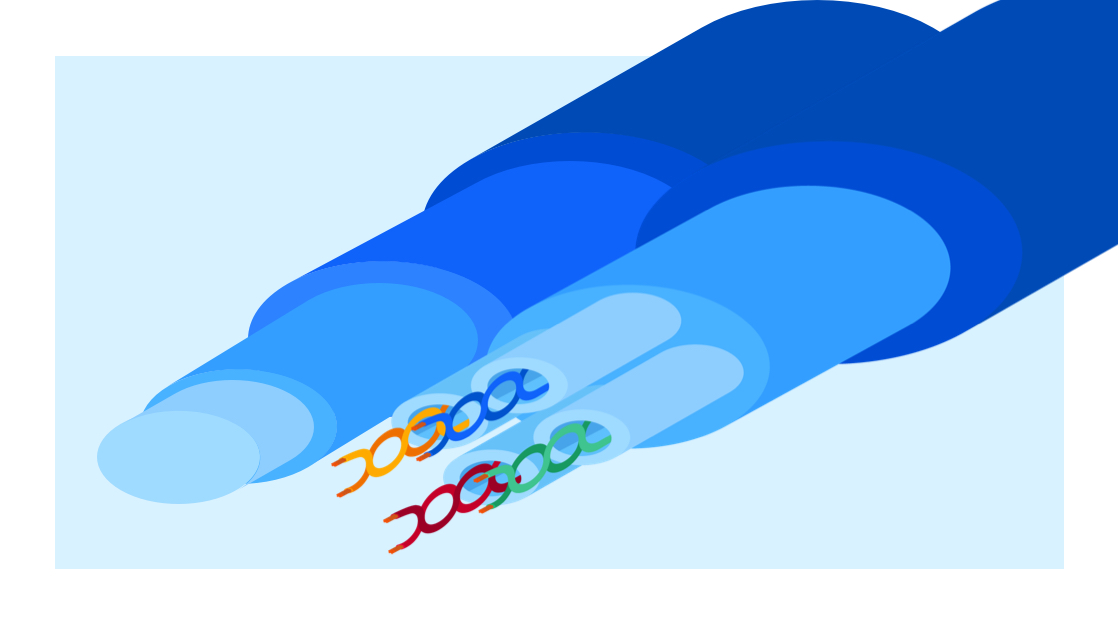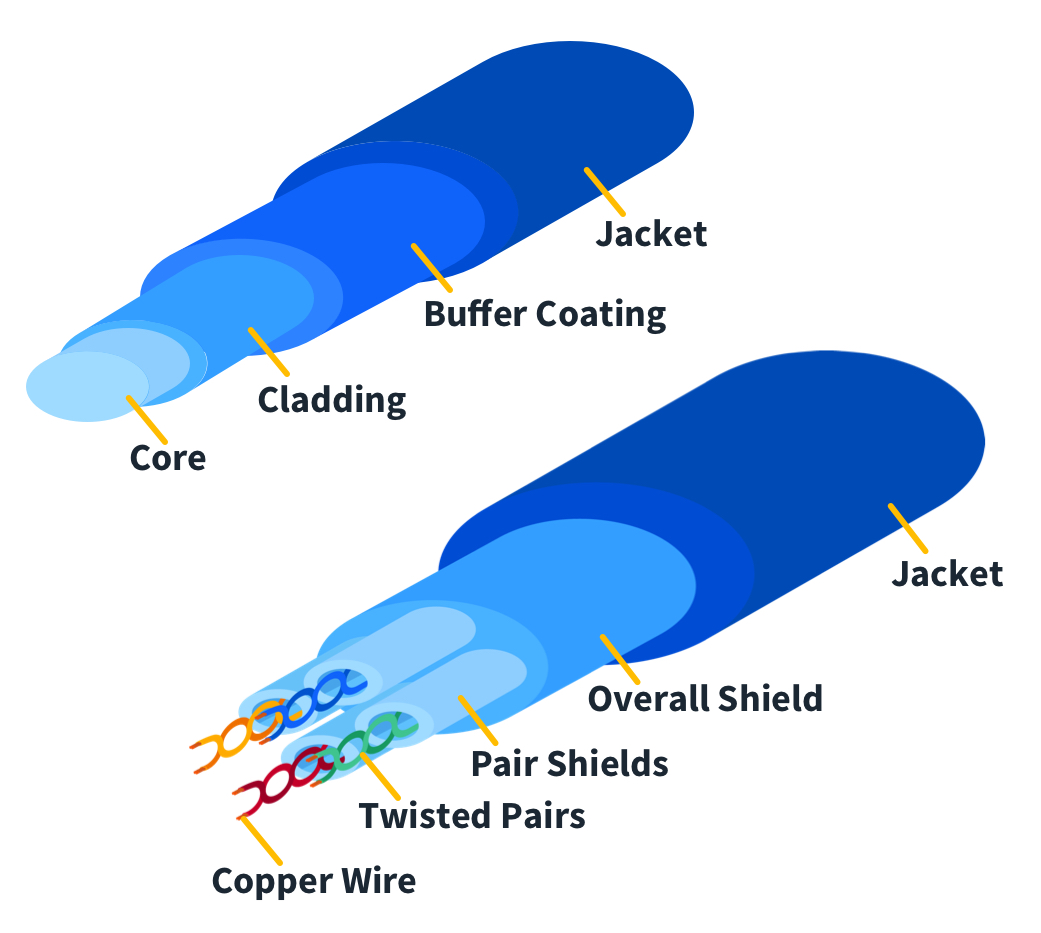What is the Difference Between Fiber vs. Copper Cable?

In the networking world, choosing the right cabling is critical. For a reliable network that meets your bandwidth needs, the first decision comes down to copper or fiber. Copper cabling is often sufficient for cost-effective and reliable network setups in shorter-range applications. However, fiber cabling is indispensable for scenarios requiring high-speed, long-distance connections, and resistance to electromagnetic interference.
It’s essential to understand the differences between the two, when to select one over the other, and how to make informed decisions for optimal data transmission. Let’s dig into these two by starting with copper.
An Overview of Copper Cable
Copper cable has been an essential part of data transmission since underground telegraph wires in the early 19th century. While today’s copper cabling is much more sophisticated than the tar-covered wires of the Old West, it remains a cost-effective and widely-used way to move bits around in today’s Ethernet networks. There are several types of copper Ethernet cabling, each with its own characteristics.
Category 5e (Cat5e) Cabling
Cat5e is one of the earliest widespread types of Ethernet cabling. It supports data transmission at speeds up to 1000Mbps (1 Gbps) at a max distance of 100 meters. It is widely used in home and small business installations as it offers sufficient bandwidth for these networks while also being very affordable. However, it offers limited resistance to electromagnetic and radio interference.
Category 6 (Cat6) Cabling
Cat6 improves on Cat5e in almost every aspect. It offers speeds of up to 10 Gbps with better resistance to interference and crosstalk. One disadvantage, though, is the maximum cable length: only 55 meters for 1 Gbps and 37 meters for 10 Gbps. Regardless, for shorter runs, like within server or network equipment racks, Cat6 offers improved performance for a moderate bump in cost, about 33% more than Cat5e.
Category 6a (Cat6a) Cabling
Cat6a improves Cat6 by adding additional shielding, reducing interference, and improving max length to 100 meter for both 1 Gbps and 10 Gbps throughput. The added shielding also adds to the cost. On average, Cat6a costs about twice as much as a Cat5e cable.
Category 7 (Cat7) Cabling
Cat7 is the Cadillac of Ethernet cabling, matching Cat6a’s speed and cable length but offering superior resistance to interference and crosstalk. For environments where the absolute highest level of performance and bandwidth are paramount, Cat7 delivers, but at a cost of around 25% more than Cat6a. Learn more about the differences between Cat6 vs Cat7 in another article.
As you can see, choosing a type of copper cable can be tricky. Bandwidth and distance are key factors, but sufficiently negating the effects of interference can save headaches down the road. All these must be balanced, of course, with cost.
Future-proofing is another factor to consider. Networks usually only grow, and more devices running apps requiring more bandwidth puts a strain on older cabling. Choosing a cable with the future in mind could prevent a costly retrofit.
An Overview of Fiber Optic Cable
Fiber-optic cabling for communication represents a huge leap forward in connectivity. Unlike copper, which transmits electrical signals across a metal medium, fiber optics transmit light through glass. This brings huge advantages in bandwidth and maximum cable length.
There are still cable choices when considering fiber optics; however, they are limited compared to copper, with only two distinct types of fiber: single-mode and multi-mode.
Single-Mode Fiber (SMF) Cabling
Single-mode fiber is superior for both long-distance and high-speed data transmission. The term “single-mode” refers to a single mode or wavelength of light going through one cable and the cable's ability to optimally carry that single wavelength.
This optimization allows for data rates of up to 400 Gbps and cable lengths of multiple kilometers. Single-mode fiber is even used for undersea runs to connect islands and continents. However, these extremely long runs require signal amplifiers at regular intervals.
Multi-Mode Fiber (MMF) Cabling
Multi-mode fiber has a much shorter max cable length than single-mode, so it is typically used within buildings or campuses to connect buildings. It also has lower bandwidth, topping out at 10 Gbps.
The choice between single- and multi-mode fiber comes down to a few critical factors. The first is distance; single-mode can reach tens of kilometers (or more with amplifiers), whereas multi-mode is reliable up to half a kilometer (or 1 km if bandwidth is limited to 1 Gbps). The next factor is bandwidth, with single-mode smoking multi-mode.
Single-mode might seem like an all-out winner, but it does have a significant downside: cost. Single-mode can easily cost twice as much for the cabling itself, and the installation is much more difficult and expensive than multi-mode. Also, multi-mode might be preferred to maintain backward compatibility with existing infrastructure.
Making the Choice: Fiber or Copper?
Like most decisions for networking projects, the decision between copper and fiber cabling comes down to your specific needs and constraints, finding a balance between distance, bandwidth, and cost. For most small businesses, copper is sufficient; anything greater than Cat6 might be overkill. One exception would be environments with high amounts of interference from sources like electric motors, fluorescent lights, or high-voltage wiring; these would require cabling with higher shielding like Cat6e or Cat7.
Another point of comparison: copper is much easier to work with. It can be installed with inexpensive hand tools and connectors by anyone with minimal training. The cable itself is much cheaper also. Fiber is much more exact, requiring expensive tools to install by trained personnel.
Fiber optic cabling has its own special use cases where it shines, generally for large business campuses, high bandwidth servers, and ISPs. Understanding these different strengths and limitations is key to building a network to serve your present and future networking needs.
Ready to delve deeper into the intricacies of networking? Dive into Keith Barker's Network+ training and more on CBT Nuggets. If you aren’t subscribed yet, start your free 7-day trial.
delivered to your inbox.
By submitting this form you agree to receive marketing emails from CBT Nuggets and that you have read, understood and are able to consent to our privacy policy.
